Contemporary artist Sachin Tekade dwells on how we tend to work hard for our physical needs but don’t offer the same kind of attention to the inner workings of our mind or soul. He deals with this self-resistance via his practice, overcoming it through his new work.
An onlooker may or may not understand the complexities and intensity of a medium, but the artist does.
Contemporary artist Sachin Tekade
Featured image: Absence. 2015. The Art Motif, Delhi.
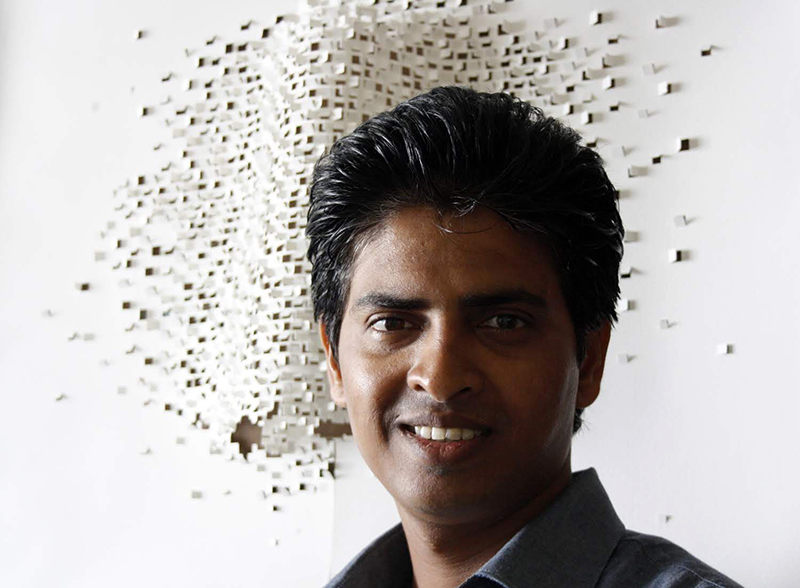
Artist portrait. Contemporary artist Sachin Tekade.
How do you describe yourself in the context of challenging people’s perspectives via your work and art?
In early 1998, when I started working with Paper, it wasn’t as common a medium as it is today, so people obviously had their doubts. In the early phases of my work, and sometimes to this day, I have a hard time convincing people that what I am making is pure minimal art.
For me, paper is sacred and I’ve always explored it as medium in a dignified way. My artworks are primarily white. Dimension, perspective, light, shadows and intricacies are purely built of the cuts on a single surface, in my work. I have to think for hours together and practice, for such work to culminate. My point is that, an onlooker may or may not understand the complexities and intensity of a medium, but the artist does. My philosophy is simple; if what I create can make a person feel that s/he is in a place of peace and bliss then I am successful as an artist.
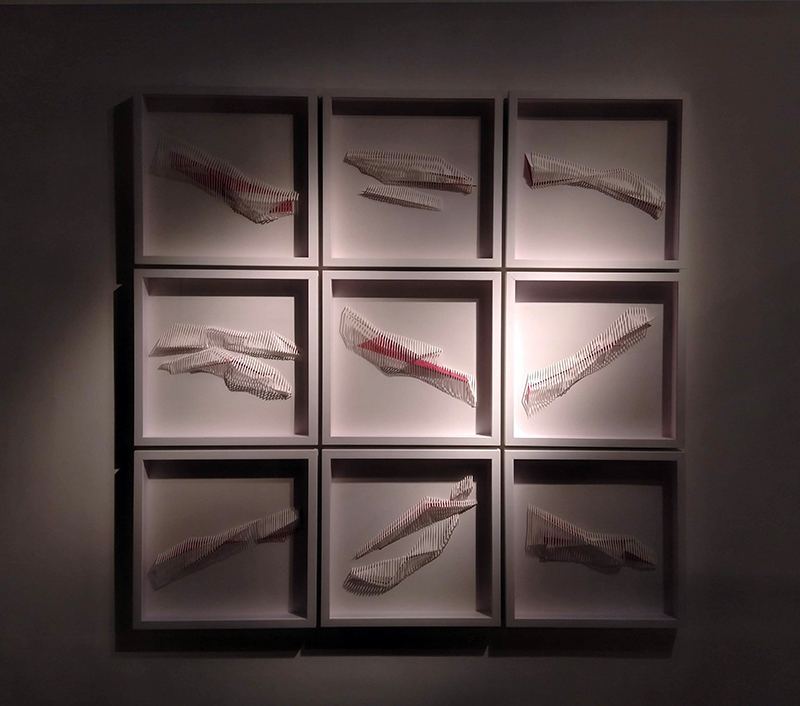
Horizon: City & Space. Contemporary artist Sachin Tekade. January 2020. AMAA Lower Parel Mumbai.
There are periods of uncertainties and anxieties, but one can always overcome these by either studying about other art practices, reading about other artists or art history.
How do you deal with the conceptual difficulty and uncertainty of creating new work?
It’s a well-known fact that great ideas appear once in a while. For me it is important to keep practicing whether or not I have a great concept. Paper is a fragile and delicate medium. To understand the extent and possibilities of this medium it’s essential that one continues their journey. A new idea is generated when I keep exploring different patterns, styles or methodologies of dealing with paper. There are periods of uncertainties and anxieties, but one can always overcome these by either studying about other art practices, reading about other artists or art history. There’s lot to learn from the past and it can always have a great impact in shaping your current practice.
Tell us about the evolution of your practice over the years. What would you call your style?
When I was in ATD (1996), I first discovered my fascination for paper as a medium, but I was, obviously, yet to discover its versatility. I continued to explore this during my BVA years at Baroda, and it led me to believe that this could be my ultimate goal.
I went to Mumbai after my degree. I did my first group show with Rukshaan Art in 2009. At this point in time, my work was still organic, and I wasn’t sure which direction I wanted to go, in terms of an artistic parlance. In 2012, I did my first solo show with Anupa Mehta at Loft Art Lower Parel, called ‘Seismic Haikus‘ and this was the moment of realisation. My work was pure white and ‘minimal’. I had developed a very personal language which also resonated with my thoughts and way of living.
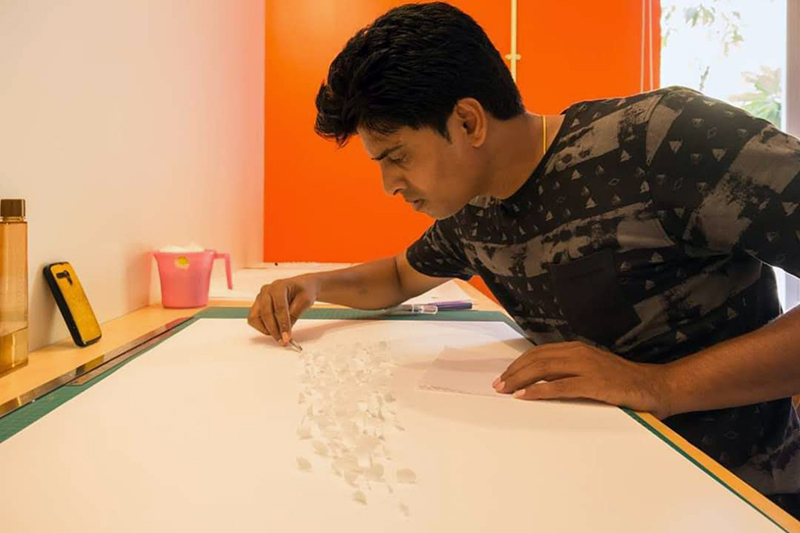
Binary. Contemporary artist Sachin Tekade. Piramal Art Residency, 2016. Thane. Image courtesy: Piramal Art Residency.
If I believe in something, I need to follow it up.
What were your biggest learnings and hiccups?
As I mentioned, until 2012, I had no clarity. I had tried various methods of survival. I was pursuing art, but it wasn’t taking the course I wanted it to. So, for a while I was doing paper models for final year architecture students. This gave me an insight into architecture, which later became a serious subject for my art. My most important learning has been that being patient and disciplined is always fruitful. If I believe in something, I need to follow it up.
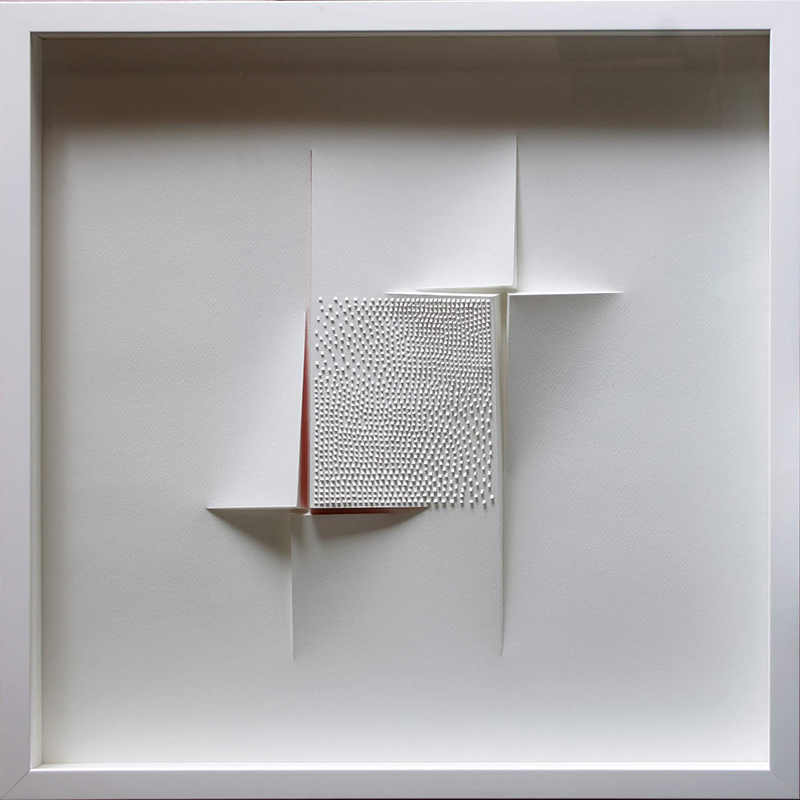
Cradle. Contemporary artist Sachin Tekade. 2016. The Loft Art Lower Parel, Mumbai.
I am aware that contemporary art is more conceptual and it is not about making art personally. So, when my audience finds out that I have created each fragment of my artwork with my own hands, they find it exciting. And for me that is very satisfying as an artist.
How does your audience interact and react to the work you put out into the world?
When someone stands in front of my work, staring at it for ten minutes, I feel that my purpose as an artist is successful. Sometimes they inquire about my technique. I do all my artwork manually, there are no machines involved. People are surprised because they mostly think it is laser-cut.
I truly believe in personal touch, even though I am aware that contemporary art is more conceptual, and it is not about making art personally. So, when my audience finds out that I have created each fragment of my artwork with my own hands, they find it exciting. For me that is very satisfying as an artist. Also, many ask about my thoughts. To be honest, I’m not trying to make a socio-political statement or narrative. My art is a way to find peace with myself. Everyone has a different purpose in life, and this is mine.
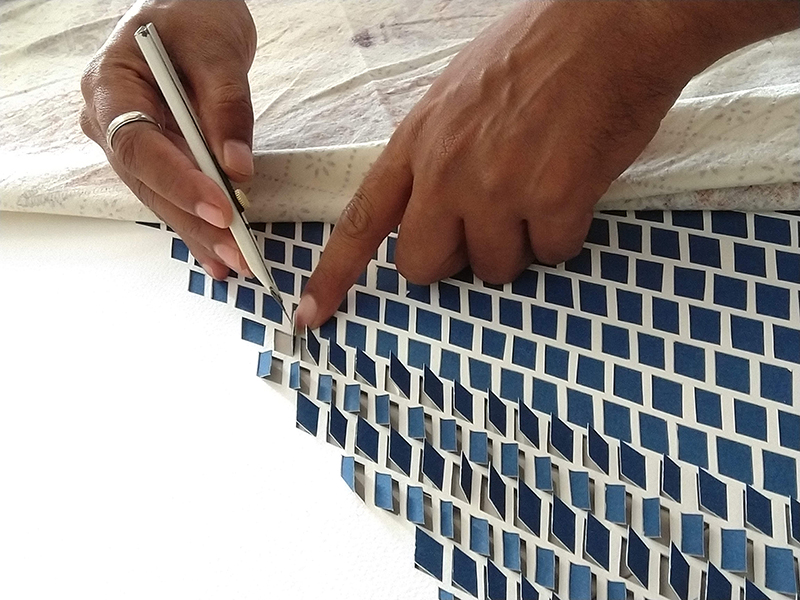
Indigo. Contemporary artist Sachin Tekade. 2019. KL Museum, Ahmedabad.
What are you working on right now? How are you balancing life and work at home during the lockdown?
This is an unfortunate scenario, and I hope and pray that we can all overcome this. This may be different for different artists, depending on their specific art practices, and perspectives. Personally, I am in a perennial quarantine of sorts, when I am in the process of creation. I usually work alone and for long periods of time I am away from all the noise of the city or social life. My current set of works is an untitled series which deals with the ways of concentrating, self-resistance or a change that you want to bring within yourself. We tend to work hard for our physical needs but we don’t stop and pay attention to the inner workings of our mind or soul.
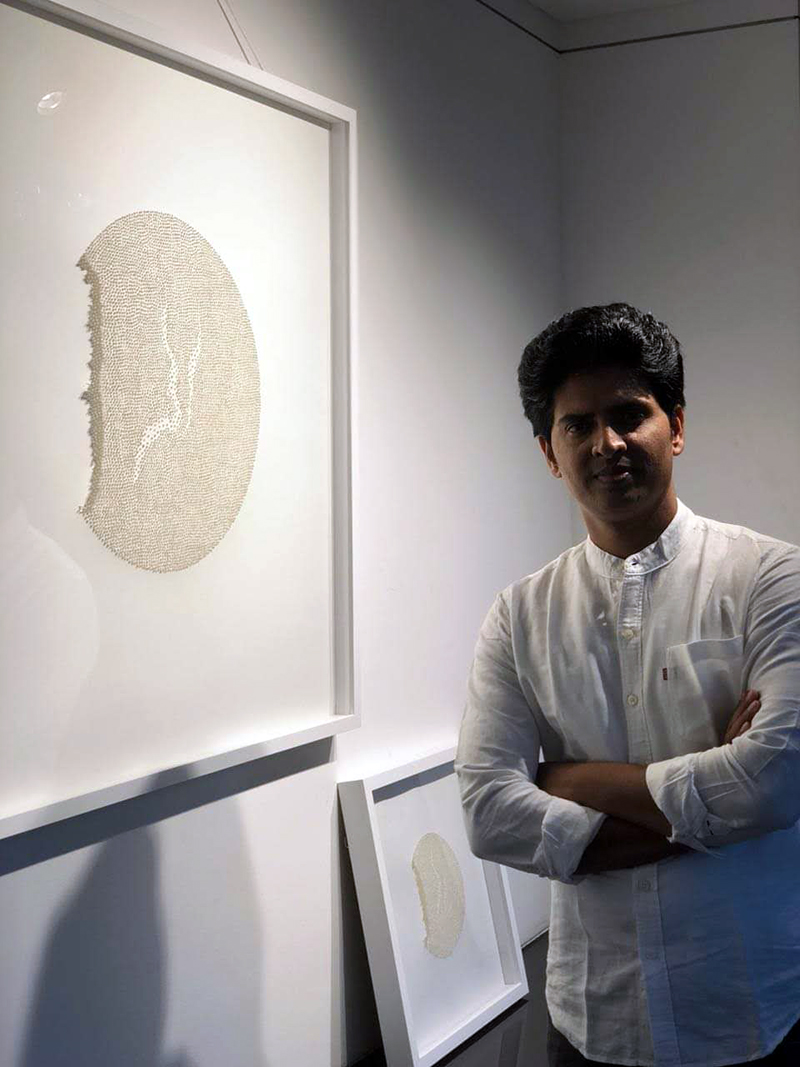
Renewal. Contemporary artist Sachin Tekade. 2018. Jehangir Art Gallery, Mumbai.
What do you look for while viewing art? Which shows, performances and experiences have shaped your own creative process? Who are your maestros?
Today’s art is uninhibited. I usually try and find myself whenever I look at an artwork. I see skill, style, subject and most importantly how it makes me feel. Also, when you start looking at an artwork closely, you understand what the artist is feeling or going through, what the unique characteristics are, and what is the psychological make-up there? I can also see the artist’s journey while looking at the canvas s/he’s created.
When I first started studying art, I studied realistic painting that eventually which led me to abstraction and minimalism. The practices I studied and have been most impacted by are the works of Michael Angelo, Picasso and V. S. Gaitonde. V. S. Gaitonde’s works have always given me spiritual vibes. There’s nothing specific, but there is definitely a feeling of being. Recently, I have been studying the works of Nasreen Mohamedi, Zarina Hashmi, Agnes Martin and Donald Judd. And I can see the effects of these on my thought process and practice.
Tell us about your artist studio, what kind of place is it? Could you describe your usual work-day in the studio?
Usually start my day at 10 AM in the morning. That way I am a disciplined person. If I have already charted out the next set of works that I want to do, then I start with paper directly. If I haven’t thought of any new ideas, then I start working on ideas with sketches. I have a small sketch book and whenever I get inspiration I tend to sketch and note it in my book. Once my ideas are fixated and I visualize a set of work I start with making miniatures of the work to see the feasibility of that concept on the paper. Generally, I leave my studio by 5.30 or 6.00 PM in the evening. But my brain never stops working on ideas, the sketching doesn’t really have a timetable.
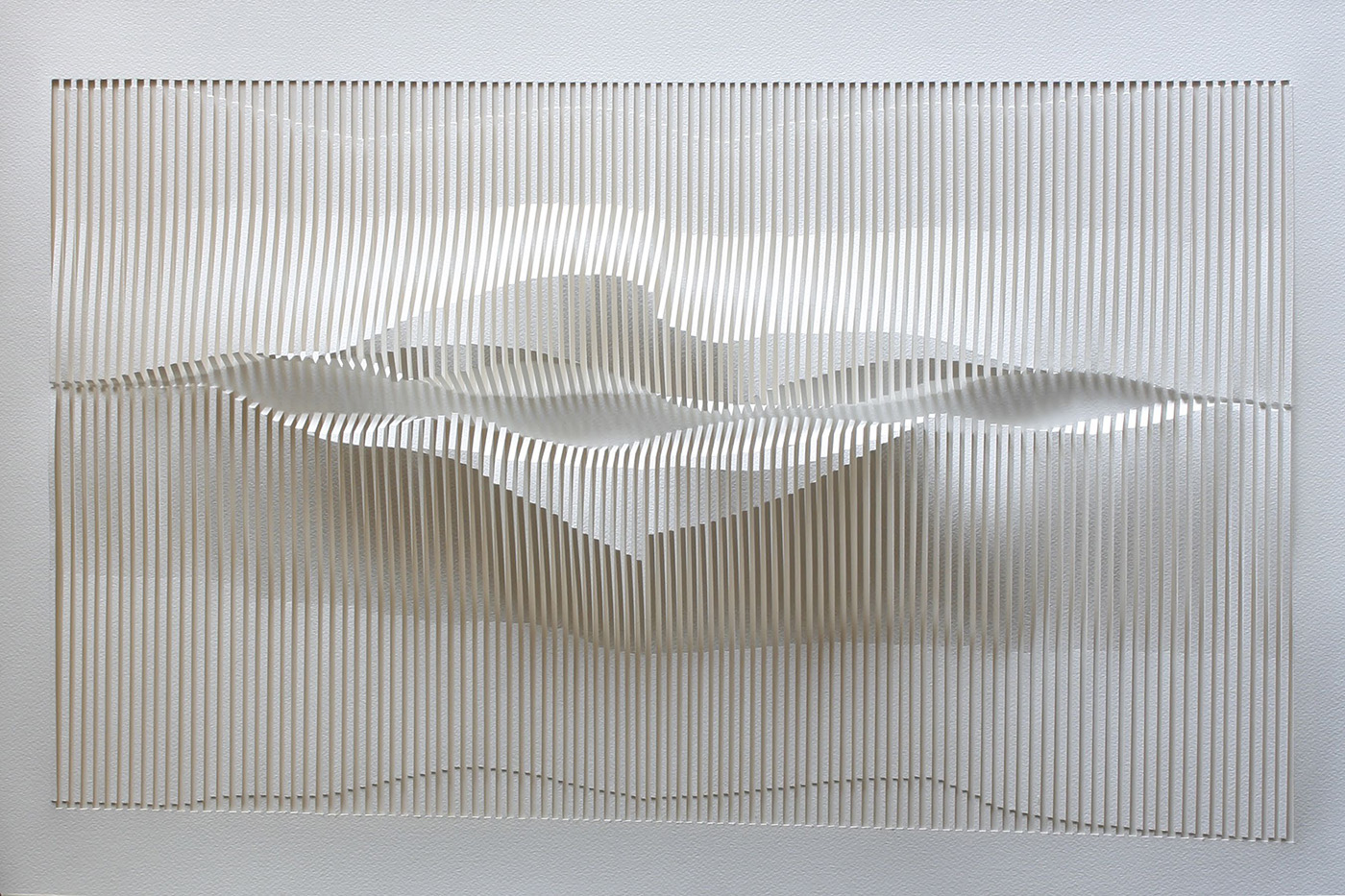
Absence. Contemporary artist Sachin Tekade. 2015. The Art Motif, Delhi.
How many works do you make in a year? How many would you like to be making?
Innumerable. I have never counted how many works I make, or want to make. Often it happens that you create works that you think are great but after thinking about it or looking at it for days together you don’t get the feeling that you have arrived with these works.
Not to sound harsh, but I tend to discard such works. Because if you cannot overcome a work you kind of get stuck with that idea and if it’s not working you have to find a way of putting it out of your system or thoughts. So, I don’t count what I create but I am aware enough to understand that I always want to create more. In my opinion, it wouldn’t be healthy to put a count on your artworks. Unlike the yesteryears, today’s world is competitive, and as an artist I need to find a way to create my own niche and overcome this.











Add Comment